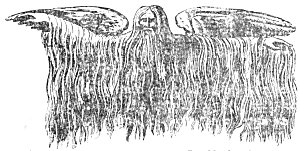The tomb of Apollo was at Delphi, where his body was laid, after Python, the Polar Serpent that annually heralds the coming of autumn, cold, darkness, and winter, had slain him, and over whom the God triumphs, on the 25th of March, on his return to the lamb of the Vernal Equinox.
In Crete, Jupiter Ammon, or the Sun in Aries, painted with the attributes of that equinoctial sign, the Ram or Lamb;–that Ammon who, Martianus Copella says, is the same as Osiris, Adoni, Adonis, Atys, and the other Sun-Gods,–had also a tomb, and a religious initiation; one of the principal ceremonies of which consisted in clothing the Initiate with the skin of a white lamb. And in this we see the origin of the apron of white sheep-skin, used in Masonry.
All these deaths and resurrections, these funeral emblems, these anniversaries of mourning and joy, these cenotaphs raised in different places to the Sun-God, honored under different names, had but a single object, the allegorical narration of the events which happened here below to the Light of Nature, that sacred fire from which our souls were deemed to emanate, warring with Matter and the dark Principle resident therein, ever at variance with the Principle of Good and Light poured upon itself by the Supreme Divinity. All these Mysteries, says Clemens of Alexandria, displaying
p. 408
to us murders and tombs alone, all these religious tragedies, had a common basis, variously ornamented: and that basis was the fictitious death and resurrection of the Sun, Soul of the World, principle of life and movement in the Sublunary World, and source of our intelligences, which are but a portion of the Eternal Light blazing in that Star, their chief centre.
It was in the Sun that Souls, it was said, were purified: and to it they repaired. It was one of the gates of the soul, through which the theologians, says Porphyry, say that it re-ascends toward the home of Light and the Good. Wherefore, in the Mysteries of Eleusis, the Dadoukos (the first officer after the Hierophant, who represented the Grand Demiourgos or Maker of the Universe), who was posted in the interior of the Temple, and there received the candidates, represented the Sun.
It was also held that the vicissitudes experienced by the Father of Light had an influence on the destiny of souls; which, of the same substance as he, shared his fortunes. This we learn from the Emperor Julian and Sallust the Philosopher. They are afflicted when he suffers: they rejoice when he triumphs over the Power of Darkness which opposes his sway and hinders the happiness of Souls, to whom nothing is so terrible as darkness. The fruit of the sufferings of the God, father of light and Souls, slain by the Chief of the Powers of Darkness, and again restored to life, was received in the Mysteries. “His death works your Salvation;” said the High Priest of Mithras. That was the great secret of this religious tragedy, and its expected fruit;–the resurrection of a God, who, repossessing Himself of His dominion over Darkness, should associate with Him in His triumph those virtuous Souls that by their purity were worthy to share His glory; and that strove not against the divine force that drew them to Him, when He had thus conquered.
To the Initiate were also displayed the spectacles of the chief agents of the Universal Cause, and of the distribution of the world, in the detail of its parts arranged in most regular order. The Universe itself supplied man with the model of the first Temple reared to the Divinity. The arrangement of the Temple of Solomon, the symbolic ornaments which formed its chief decorations, and the dress of the High Priest,–all, as Clemens of Alexandria, Josephus and Philo state, had reference to the order of the world. Clemens informs us that the Temple contained many emblems
p. 409
of the Seasons, the Sun, the Moon, the planets, the constellations Ursa Major and Minor, the zodiac, the elements, and the other parts of the world.
Josephus, in his description of the High Priest’s Vestments, protesting against the charge of impiety brought against the Hebrews by other nations, for contemning the Heathen Divinities, declares it false, because, in the construction of the Tabernacle, in the vestments of the Sacrificers, and in the Sacred vessels, the whole World was in some sort represented. Of the three parts, he says, into which the Temple was divided, two represent Earth and Sea, open to all men, and the third, Heaven, God’s dwelling-place, reserved for Him alone. The twelve loaves of Shew-bread signify the twelve months of the year. The Candlestick represented the twelve signs through which the Seven Planets run their courses; and the seven lights, those planets; the veils, of four colors, the four elements; the tunic of the High Priest, the earth; the Hyacinth, nearly blue, the Heavens; the ephod, of four colors, the whole of nature; the gold, Light; the breast-plate, in the middle, this earth in the centre of the world; the two Sardonyxes, used as clasps, the Sun and Moon; and the twelve precious stones of the breast-plate arranged by threes, like the Seasons, the twelve months, and the twelve signs of the zodiac. Even the loaves were arranged in two groups of six, like the zodiacal signs above and below the Equator. Clemens, the learned Bishop of Alexandria, and Philo, adopt all these explanations.

Moe is the founder of GnosticWarrior.com. He is a father, husband, author, martial arts black belt, and an expert in Gnosticism, the occult, and esotericism.





